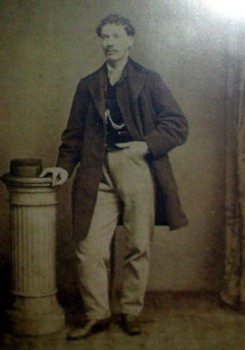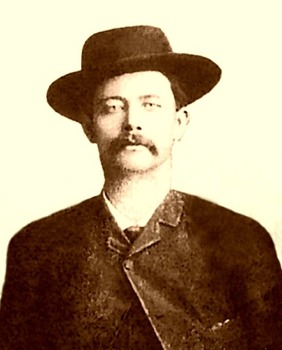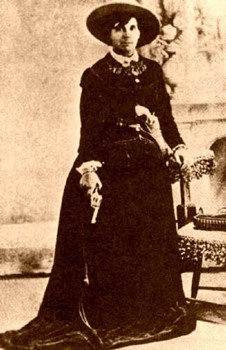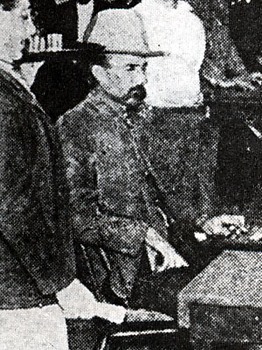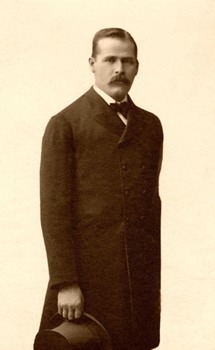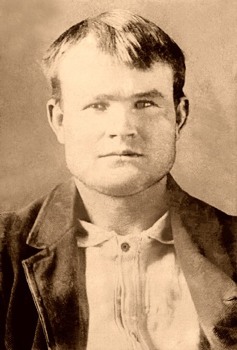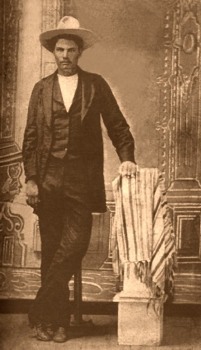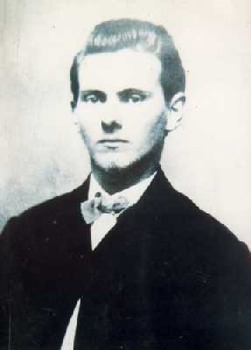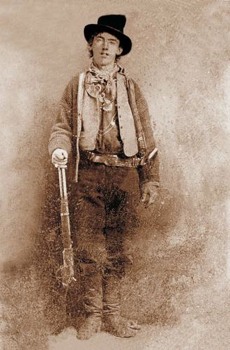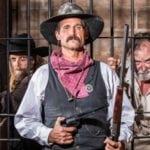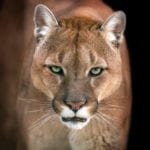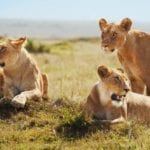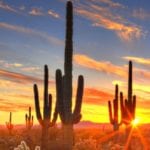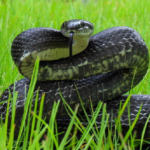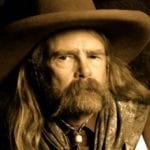“Curly Bill” was so-called because of his head of thick, curly black hair. After the death of “Old Man” Clanton, he became the leader of the “Cowboys” gang of cattle rustlers in Tombstone, Arizona. He also worked for a while as a tax collector for Cochise County Sheriff John Behan. Curly Bill was a heavy drinker who became even more rambunctious when drunk. One night, while drinking with other Cowboys, he was asked by Marshal Fred White to give up his pistol. In handing the gun over to the Marshall, it accidentally discharged, hitting White. Fred White, who had been friendly with Curly Bill, made a statement on his deathbed that he believed the shooting was an accident and Brocius was acquitted. Wyatt Earp testified in his defense, but later shot and killed him in retaliation for the murder of his brother Morgan Earp.
Sam Bass started out an honest man. After running away from the abusive uncle who raised him, he went to work in a sawmill in Mississippi. His dream was to be a cowboy and he eventually made his way to Texas. After one season, he decided he didn’t like it. In 1876, Bass and a rough character named Joel Collins drove a herd of longhorns up north where the prices for cattle were higher. They were supposed to go back to Texas to pay off the owners of the herd, but instead they took the $8,000 profit for themselves. He and Collins wasted the money from the cattle drive on gambling in Deadwood. A few months later, he and Collins went into another venture- stagecoach robbery. After holding up seven stagecoaches, they didn’t make much money. They set their sights on bigger prizes and turned to train robbery. Bass and his gang robbed the Union Pacific gold train from San Francisco, netting over $60,000, which is to this day the largest single robbery of the Union Pacific. He was wounded by Texas Rangers on the way to rob a small bank in Round Rock, and died two days later on his 27th birthday.
Myra Maybelle Shirley was born in Carthage, Missouri. As a young lady, she attended the Carthage Female Academy where she excelled in all subjects and became an accomplished pianist. She grew up with Cole Younger and later befriended the James brothers. When the outlaws of the James-Younger gang needed to hide out, they often stayed at the Shirley family farm. It wasn’t long before Maybelle was introduced to a life of crime and earned the nickname “The Bandit Queen.” In 1866, Belle married Jim Reed, a former Confederate Army guerrilla. Jim Reed tried to live the honest life of a farmer, but when that didn’t pan out, he fell in with the Starrs, a Cherokee Indian family notorious for stealing horses. Along with his wife’s friends, the Jameses and Youngers, they planned and executed many daring heists. Jim was killed while trying to escape from the custody of a deputy sheriff who had arrested him for one such robbery. After the loss of her husband, Belle made her living organizing and planning robberies, as well as fencing stolen goods. When she was unable to bribe the law into looking the other way, she would seduce them to get what she wanted. She married Sam Starr in 1880, and two years later, both of them were convicted of stealing horses. They were released a year later and went right back into lawlessness. Belle was murdered on Feb. 3, 1889, two days before she was to turn 41. She was shot in the back while riding home from the general store. Her killer has never been identified.
Cole Younger’s life was forever changed when his father was murdered by Union Captain Walley. Mr. Younger had given Walley a severe beating for making advances on his daughter (Cole’s sister). Cole was already a member of Quantrill’s Raiders but after the murder of his father, he joined the Confederate Army. It is not for certain when he went into banditry, but the first time he was mentioned as a suspect was after the 1868 robbery of Nimrod Long & Co., a bank in Russellville, Kentucky. Cole and his brothers formed a gang with Jesse and Frank James. They robbed stagecoaches, trains, and banks in Missouri, Kentucky, Kansas, and West Virginia. Luck ran out for the Younger boys on September 7, 1876 during a botched bank robbery. Cole and his brothers Jim and Bob pled guilty to avoid the hangman’s noose. They were sentenced to life, but were paroled in 1901. Cole toured the nation with Frank James giving speeches about the Wild West. He later became a Christian and renounced his criminal past and died peacefully 4 years later, with 11 bullets still embedded in his body.
James Miller was also known as “Deacon Jim” because he went to church and did not smoke or drink. Despite his piousness, he was actually one of the deadliest guns in the Wild West. He openly stated that he would kill anyone for money, and his rate was reported at anywhere from $150 to $2,000. Miller’s usual method was to ambush his victims at night using a shotgun and wearing a black frock coat, making him hard to see in the darkness. His coat also concealed a steel plate he wore on his chest to protect him from opposing gunfire, an early version of a bullet-proof vest. He is known to have committed 14 murders, but rumors swelled that number to 50. He was arrested in Oklahoma, for the murder of A.A. “Gus” Bobbitt. Not wanting to leave it up to a jury, a lynch mob dragged Miller and three others out to an abandoned stable to be hanged. Before he died, he made two requests. He wanted his ring to be given to his wife (who was a cousin of John Wesley Hardin) and to be allowed to wear his hat while being hanged. He went out on his own terms, shouting “Let ‘er rip!” before he jumped off his box to his death. His body and the bodies of the other three men lynched that night were left hanging for hours until a photographer could be found to immortalize the event.
The Sundance Kid (Henry Longabaugh) earned his nickname when he was caught and convicted of horse thievery in Sundance, Wyoming. Despite his reputation as a gunfighter, he is not certain to have actually killed anyone. After his release from jail in 1896, he and Robert LeRoy Parker aka “Butch Cassidy” formed the gang known as the Wild Bunch. They were responsible for the longest string of successful train and bank robberies in American history. Due to the pressure of the Pinkerton Detective Agency on their trail, Sundance, Butch, and Etta Place left the United States for Argentina to let things cool down. He is believed to have been killed in a shootout in Bolivia, but several family members claim he actually returned to the states, changed his name to William Henry Long, and lived in the small town of Duchesne, Utah until 1936. As of this writing, Long’s body has been exhumed and is undergoing DNA testing to determine the truth.
In 1879, at the age of 13, Robert LeRoy Parker (Butch Cassidy) lived and worked with his family on the ranch of Jim Marshall in Circleville, Utah. It was there that he met his friend and mentor, Mike Cassidy who gave Bob his first gun and taught him how to shoot. Years later, Bob would take his last name, Cassidy, as a tribute. His first run-in with the law occurred when he rode into town to buy a new pair of overalls. The general store was closed, so Bob let himself in, found a pair that fit, and left a note promising that he would be back to pay later. The merchant reported him to the Sherriff, but he was acquitted of any crime. On June 24, 1889, he and three others robbed the San Miguel Valley Bank in Telluride, netting $21,000. With this money, he bought a ranch near the infamous “Hole-in-the-Wall” outlaw hideout. Parker, by this time “Butch Cassidy”, was never a very good rancher, and it is believed to have simply been a cover for his illegal activities. In 1896, he became the leader of the infamous group of criminals known as the Wild Bunch that included some of the most well-known outlaws of the Wild West. As with the Sundance Kid, it is unknown if he really died in Bolivia, or if, as some relatives claim, he returned to America.
The son of a Methodist preacher, he was named after the founder of the Methodist faith. When he was only 14 years old, he stabbed a boy for taunting him. A year later, he was playfully wrestling with an ex-slave named Mage. He scratched Mage’s face, and the next day, Mage hid on a path and attacked Hardin in retaliation. Hardin fired three warning shots, but when Mage didn’t back off, Hardin was forced to shoot him in self-defense. Mage died as a result. Since many of the Texas State Police were themselves former slaves, and Hardin was a “Johnny Reb”, he didn’t stand a chance of a fair trial. He went into hiding and was warned by his brother when the police found out where he was. He did not run, but stayed and fought instead. He killed all three policemen and evaded the law. Several arrests and escapes later, he ended up in Abilene, Kansas, where he befriended “Wild Bill” Hickok. While in Abilene, he stayed at the American House Hotel. When the stranger in the next room wouldn’t stop snoring, he fired a gun into the ceiling twice. The first shot woke the man up, and the second one killed him. Hardin made his escape out of the window and left for Texas. Many skirmishes with the law followed, and he was finally captured, convicted, and went to jail for seventeen years. During his time incarcerated, he finished his law degree and practiced as a lawyer upon his release. He died when he was shot in the back of the head while playing dice.
Jesse James was born in Missouri, and along with his brother, Frank, was a Confederate guerrilla fighter during the Civil War. After the war, the James boys joined the Younger brothers and formed the James-Younger Gang. Together, they robbed banks, stagecoaches, and trains. In 1869, the gang held up the Daviess County Savings Association in Gallatin, Missouri. Jesse shot and killed a clerk, believing him to be someone else. When he realized his terrible mistake, he began a correspondence with John Newman Edwards, editor and founder of the Kansas City Times. Edwards had fought for the Confederacy also, and was sympathetic to the James brothers. He ran many admiring articles about the gang and published Jesse Jame’s letters to the public, in which he declared his innocence. These articles raised his public profile and made him a kind of folk hero. Though he was famous while alive, he became even more so in death, when he was shot in the back of the head in his own home by trusted friend Robert Ford. His mother, Zerelda James chose this epitaph for her son : “In Loving Memory of my Beloved Son, Murdered by a Traitor and Coward Whose Name is not Worthy to Appear Here.”
There is no outlaw more legendary that Billy the Kid. Countless books, movies, and songs have been written about his life, but the reality was not quite as sensational. Often portrayed as a cold-blooded killer, he entered a life of crime out of necessity, not malice. People who knew him personally called him brave, resourceful honest, and full of laughter. Under different circumstances, he could have been a successful man. It has been said that he killed 21 people, one for each year of his life, but he was probably only responsible for four. In 1877, he went to work as a cattle guard for rancher, John Tunstall. Tunstall was embroiled in a bitter dispute with the local merchants Lawrence Murphy and James Dolan. On February 18, 1878, Tunstall was murdered by Murphy’s workers while herding his cattle in the open range. He was unarmed and alone. This event started what would be called The Lincoln County War. Enraged, the ranch hands, including Billy, were deputized and given the warrants to bring in the Murphy men. They called themselves the Regulators. Due to the corruption of the day, the governor sided with Murphy, and the Regulators became the enemy. After a daring escape from jail, and a few years on the run, he was shot and killed by Sheriff Pat Garrett while hiding out in a friend’s home. Over the years, several people have claimed to be Billy the Kid, but the chance that he survived and/or his body was misidentified are highly unlikely.
